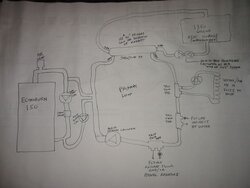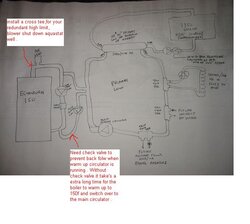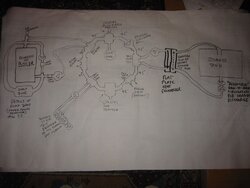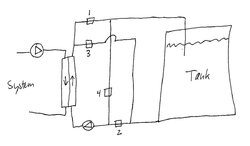pybyr said:
Joe- can you remind me or summarize why you prefer a HX-based system (with a discrete heat exchanger, whether it be plate or shell and tube, outside the tank) to a coil in the tank (its own form of HX but within the tank?
Oh, I wouldn't say that I "prefer" it. Each system has its place, and I like both methods, when each is done right. You seemed to be leaning in that direction, so I gave my input on it that way. The stainless immersed heat exchanger is also a good option.
I'd say that the biggest advantage that external heat exchangers have is controllability/serviceability. Because the components are external to the tank, you can adjust them and maintain them without having to open the tank, disconnect a coil, and drag it out of the water.
More pumps and valves and such mean greater flexibility. They also mean more potential failure items, and more electric draw. It's all a balance, and the difficulty always ends up being that there is no "one right" answer." There are several right answers.
Some factors, for example: in a location with low headroom, the physical act of removing an immersed coil from a tank for maintenance might not be possible. The coil is usually almost as tall as the tank, so that means having headroom that is nearly double the tank height. Once a tank is installed, you're not going to want to partially collapse it in order to pull a coil if it springs a leak. If you find that the coil is not sufficient (either through a design flaw, or because of future expansion), and need to add another coil, the same issue can arise.
External heat exchangers avoid that. If a plate heat exchanger starts leaking, or is found to be inadequate, you can just shut off the isolation valves (always install isolation valves), loosen the unions (always install them with unions), and then replace it with another. On the other hand, if you have limited electric power (eg, a strong desire to use less, or a requirement to use less because of an off-grid power system), the extra/larger pumps may be an issue. Immersed coils use fewer pumps and a multi-parallel coil can have much lower head loss than most external heat exchangers, so smaller pumps can be used. You can also install parallel or variable-speed pumps, allowing you to use less pumping electricity when demand is low, especially on the discharge side.
There are other advantages and disadvantages to the two designs, and it really comes down to what will be best for a particular application. You won't "go wrong" by choosing one or the other. It's just a matter of weighing which you think will be the best for your needs. All heat exchangers involve compromise (and going to a pressurized system involves compromise in terms of needing a pressure-rated tank and a large expansion vessel). It's just a matter of choosing which of those compromises will be best for you.
Joe





